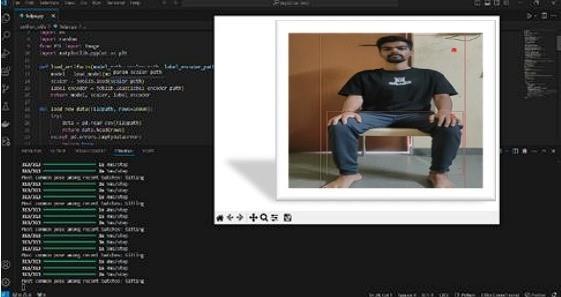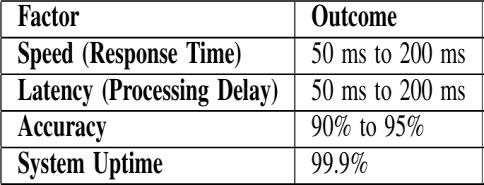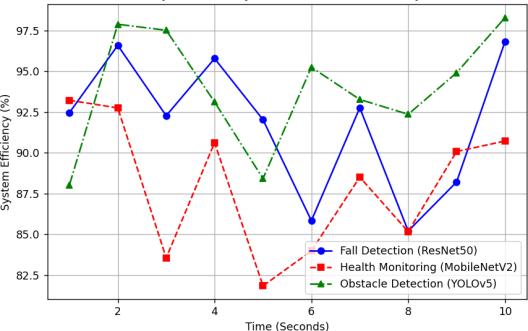
International Research Journal of Engineering and Technology (IRJET) e-ISSN: 2395-0056
Volume: 12 Issue: 05 | May 2025 www.irjet.net p-ISSN: 2395-0072


International Research Journal of Engineering and Technology (IRJET) e-ISSN: 2395-0056
Volume: 12 Issue: 05 | May 2025 www.irjet.net p-ISSN: 2395-0072
Prof. Rajesh Bulbule1 , Prathamesh Sonawane2 , Bhavesh Choudhary3 , Mayur Thube4
1 Professor, Department Of ENTC, Dr. D Y Patil Institute of Technology Pimpri, Pune, India 2,3,4UG Student, Department Of ENTC, Dr. D. Y. Patil Institute of Technology Pimpri, Pune, India
Abstract - As the global population ages, many elderly individuals especially those over 60 face distinct challenges in maintaining their independence and qualityoflife.Numerous olderadults,particularlythose livingalone,lackconsistentoversightandpersonalcare, which can lead to significant health and safety issues. Without regular check-ins, problems like falls, medication mismanagement, and unreported emergenciescan occur, oftenresultinginserioushealth complicationsoreventragicoutcomes.Thesesituations not only affect the individuals involved but also place emotional and financial burdens on their families and healthcare systems.
Totacklethesechallenges,innovativee-healthsolutions are becoming increasingly vital. Advances in technology especially artificial intelligence (AI) and the Internet of Things (IoT) have the potential to transform elder care. Smart sensors, wearable devices, and intelligent monitoring systems can provide more than just fall prevention; they can deliver continuous, real-time support tailored to each individual’s needs. Picture an AI-powered assistant that re- minds an elderly person to take their medications, tracks their overall health,monitors theiremotionalwell-being,and even alerts caregivers in case of an emergency. These smartsolutionscreateasafetynet,enablingolderadults to live more independently while ensuring they are never truly alone. By embracing these technologies, we can help our aging loved ones feel more secure, supported, and connected in their daily lives.
Index terms: Artificial Intelligence (AI) Internet of Things (IoT) E-health Smart Sensors.
1.INTRODUCTION
In2022,therewereapproximately149millionindividuals aged60andolderinthecountry,accountingforabout10.5 percent of the total population as of July 1. This figure is projectedtodoubleby2050,reaching20.8percent,which translatestoaround347millionpeople.Bytheendofthe century, the elderly will represent over 36 percent of the nation’spopulation.
By 2046, the elderly population in India is expected to exceedthenumberofchildrenaged0-14years.Additionally, theproportionofindividualsaged15–59yearswillalsosee
adecline.Currentlyarelativelyyoungnation,Indiaisonthe pathtobecominganagingsocietyinthecomingdecades.
Whenelderlyindividualslivealone,thereisasignificantrisk thatiftheyfall,noonewillbetheretohelp.Thiscanresultin severeconsequences,includinglife-threateninginjuriesor even fatalities. To mitigate such risks, it is crucial to implementsystemsthatcandetectfallsandpromptlyalert caregivers,familymembers,oremergencyservices.
Variousstudieshaveproposedmonitoringhomeappliances to assess the well-being of elderly individuals. However, these systems often struggle to adapt to changes in daily habits.Real-timefalldetectionandinterpretinganelderly person’sexpressionsremainchallenging.Whilesurveillance cameras are commonly used in public areas, their applicationinprivatehomesislimitedduetoprivacyissues. Wearabledevicessuchasrings,pendants,andwatchescan assist in fall detection, but they depend on the elderly wearingthemconsistentlyandkeepingthemcharged,which maynotalwaysbefeasible.
Researchinrobottherapyhasindicatedthatuser-friendly robots can offer support without inducing stress for their users.
In recent years, the use of machine learning and deep learning models in healthcare has surged, significantly enhancing diagnosis, treatment, and patient care, particularlyinmonitoringandassistingtheelderly.These models are highly effective in detecting health issues and ensuringsafety,offeringimprovedaccuracyandefficiency. Amongmanymethodologies,thisprojectdrawsfromseveral keystudiesinthedomain.
Convolutional neural networks (CNNs) like ResNet50 and MobileNetv2 have been discussed extensively in the literatureforimage-basedclassificationtasks.ResNet50,a populararchitectureforresiduallearning,helpsaddressthe vanishing gradient problem that arises in deep networks, making it suitable for complex pattern identification. MobileNetv2,ontheotherhand,isalightweightarchitecture that provides an extremely efficient solution for mobile applications,particularlyinscenarioswherehighaccuracy mustbeachievedwithlowcomputationalpower.Thismakes MobileNetv2asuitablechoiceespeciallyinreal-timemobile solutionsforelderlycare.

International Research Journal of Engineering and Technology (IRJET) e-ISSN: 2395-0056
Volume: 12 Issue: 05 | May 2025 www.irjet.net p-ISSN: 2395-0072
Further,objectdetectiontechniquessuchasYOLOv5(You OnlyLookOnce)arepivotalinidentifyingspecific regions withinthebody,assistingwithearlydetectionofpotential issues.YOLOv5excelsinreal-time,multi-regiondetection,a crucial feature for health monitoring applications that requirefast,accurateidentification.Manyhavesuccessfully appliedYOLOv5tohealthcarescenarios,demonstratingits abilitytobalancespeedandprecision vitalforapplications where immediate intervention is necessary, such as fall detectionandmonitoringvitalsigns.
This project focuses on creating a comprehensive system thatintegratesadvancedtechnologieswithreal-timealert capabilitiestoensurethewell-beingofelderlyindividualsby notifying caregivers during critical situations. By utilizing CNNmodelslikeResNet50andMobileNetv2,thesystemcan analyze data with high accuracy while remaining efficient andlightweight,makingitsuitableforresource-constrained environments.Tobringthesefeaturestolife,wedevelopeda mobilerobotthatusesanESP32microcontroller,ESP-CAM, ultrasonicsensors,andIR sensorstocollectdata,monitor theenvironment,anddetectpotentialconcerns.Therobot actsasanintelligentassistant,capableofnavigatingvarious settings,analyzingitssurroundings,andsendingreal-time alertstocaregivers,enablingthemtorespondpromptlyto emergencies. This system also incorporates multilingual support to accommodate caregivers from diverse backgroundsandensuresaccessibilitythroughuser-friendly interfaces.Additionally,thereal-timenotificationsystemcan alert nearby caregivers during widespread risks or emergencies, creating a collaborative safety network. By combining cutting-edge technology with practical applications, the project aims to foster a supportive and secureenvironment,improvingtheoverallqualityoflifefor elderlyindividualswhilereducingtheburdenoncaregivers.
In general, research in this area demonstrates the practicalityofdeployingCNN-basedmodelslikeResNet50 and Mo- bileNetv2 for health monitoring, as well as the effectivenessofobjectdetectiontechniqueslikeYOLOv5for real-timeidentificationofhealthissuesintheelderly.This projectaimstoprovideaccurate,in-timehealthmonitoring supportedbyreal-timealertsandpreventiontechniquesto limithealthrisksandenhancetheoverallqualityoflifefor elderlyindividuals.RelevantMLandDLTechniquesforthe Smart Elderly Assistant System: Convolutional Neural Network for Image Classification: Recent studies have proposedCNNarchitectureslikeResNet50andMobileNetv2 forimageclassification
ResNet50:TheresiduallearningframeworkofResNet50is particularly helpful in avoiding the vanishing gradient problem,makingitsuitableforidentifyingsubtlepatterns

ActivityRecognitionandAlerts
and anomalies in data related to elderly care, such as changes in daily activity patterns or mobility levels. MobileNetv2:Thislightweightarchitectureoffersanefficient solution where resources are limited, ensuring accurate processingwithminimalcomputationalpower.Thismakesit ideal for portable devices designed for assisting elderly individualsorsmarthomesensors.ElderlyAssistanceUsing ObjectDetection:YOLOv5isthemostprominentmodelfor real-timeobjectdetection.
Multi-regionDetection:YOLOv5allowsfortheidentification of multiple objects in a single pass, making it suitable for applicationssuchasmonitoringtheplacementofhousehold items, tracking medication intake, or detecting potential hazards in the living environment. Speed and Precision: YOLOv5 offers a strong balance between speed and precision,whichisessentialforreal-timeapplicationslike falldetection,identifyingunattendedobjects,orrecognizing gestures to trigger specific assistance tasks. Research on ElderlyAssistanceSystems:ManystudieshaveusedYOLOv5 forapplicationsfocusedonelderlysupport,particularlyfor creating smart environments that promote safety and independence.Itscontributionliesinreal-timedetectionand analysis,enablingtimelyinterventionstopreventaccidents and improve overall quality of life for elderly individuals. Real-Time Alarm Systems for Health Monitoring: Recent advancementshaveintegratedMLandDL-basedelderlycare with real-time alarm systems to notify caregivers about potentialhealththreatsinelderlyindividuals.Neighboring Alerts: In case of widespread health risks or emergencies, notifications will be sent to nearby caregivers to take preventiveactions.
The methodology for the smart elderly assistant system beginswithgatheringdatafromvarioussourcestomonitor theuser’shealthandsurroundings.Thisdataisthensentto acentralmicrocontroller,whichprocessestheinformation inreal-time.Thesystemusessoftwarethatinterpretsthis data totrack vitalsigns,detectchangesinmovement,and assesstheenvironmentforpotentialrisks,suchashazards in the home or health issues like irregular heart rates. AI algorithmsanalysepatternsinthedata,allowingthesystem

Volume: 12 Issue: 05 | May 2025 www.irjet.net p-ISSN: 2395-0072
to predict when the user may be at risk of a fall, health complication, or environmental danger. Based on this analysis, the system can send alerts to caregivers or emergencycontacts,ensuringhelpisalwaysavailablewhen needed. In case of an emergency, the system can trigger automaticresponses,likenotifyingmedicalprofessionalsor activatingsafetymeasuresinthehome.
A. System DesignandIntegration: Thesystemdesignand integrationforthesmartelderlyassistantsystemfocus on seamlessly combining hardware and software to ensurecontinuousmonitoringandsafety.Atthecoreof thesystemistheESP32microcontroller,whichintegrates withvarioussensors,suchasPIR,IR,andultrasonic,to monitortheuser’shealthandenvironment.TheESP32CAM is included to provide visual data, enhancing the system’s ability to assess situations like falls or emergencies.
B. Data Transmission and Monitoring: In the smart elderly assistant system, data is continuously collected from the user’s health and environmental sensors and transmittedwirelesslytoacentralsystemformonitoring. This allows care- givers or healthcare professionals to receive alerts about the user’s well-being, such as any potentialrisksorhealthissues.Thesystemensuresthat anyalarmingchanges,likeafallorab-normalvitalsigns, are quickly detected and communicated to those responsiblefortheuser’scare,enablingaswiftresponse. Withthiscontinuousdatatransmissionandmonitoring, thesystemoffersasafetynet,providingreassurancethat theuserisalwaysbeinglookedafter.
C. MachineLearning: Inthesmartelderlyassistantsystem, machine learning algorithms are used to analyse data from various sensors, helping the system predict and respondtopotentialrisks.Bytrainingonhistoricaldata, these algorithms learn to recognize patterns and make accuratepredictionsabouttheuser’ssafety.Forinstance, classification algorithms can detect falls or unusual movements based on motion or environmental sensor data. Anomaly detection algorithms are employed to identify irregular patterns, such as a sudden lack of movement or the presence ofhazardslike obstaclesor changes in the environment. When these issues are detected, the system triggers alerts to caregivers or emergencycontacts.

1) ESP32 Cam: TheESP32Camisusedforcapturing real- timevideoandimages. Itcomeswithanintegrated camera module capable of taking high-resolution photos andstreamingvideo.DatacanbetransmittedviaWi-Fior Bluetooth, making it useful for remote monitoring of elderlyindividuals.Thisallowscaregiverstoobserveand detectunusualactivity,helpingensuresafetyandprompt responsestopotentialissues.
2) L298N Motor Shield: The L298N motor shield is designed to control DC and stepper motors. It uses HBridge circuits, which enable current to flow in both directions, thus allowing motors to move forward and backward.Inelderlyassistancesystems,thisisparticularly beneficial for enabling movement in robotic aids that respondtocommandsandassistwithvarioustasks.
3) IRSensor: Infrared(IR)sensorsemitinfraredlight and detect the signal reflected back to measure the proximity of objects. This sensor is suitable for obstacle detection, as it can identify when an object is nearby. It playsakeyroleinnavigationsystemswithinsmarthome setups,ensuringsafemovementforassistancerobotsand alerting when the elderly move or come close to certain areas.
4) Ultrasonic Sensor: Ultrasonicsensorsoperateby emit-tingsoundwavesandtiminghowlongittakesforthe echo to bounce back after striking an object. This measurement allows for distance calculation, which is essential for safe navigation in robots and for detecting suddenmovementsthatmayindicateemergencies,suchas falls.
5) VL53L0X Sensor: TheVL53L0XisaTime-of-Flight (ToF)sensorthatmeasuresthetimetakenforalightpulse toreflectbackfromanobject,allowingforpreciseshortdistancemeasurement.This sensorhelpscreatedetailed spatialawarenessforelderlyassistancesystems,whichcan aidinobstacleavoidanceandenhancesafetybydetecting nearbyobjects.

International Research Journal of Engineering and Technology (IRJET) e-ISSN: 2395-0056
Volume: 12 Issue: 05 | May 2025 www.irjet.net p-ISSN: 2395-0072
6) PIR Sensor: The Passive Infrared (PIR) sensor detectsmovementbysensingvariationsinheatemittedby peopleorobjectsinitsenvironmentWhenapersonmoves withinitsdetectionfield,itregistersthischangeandsends asignal.Forelderlymonitoring,thissensorisvaluablefor detectingactivityorsignalingifthereisalackofmovement overacertainperiod,potentiallyindicatinganemergency.
A. Data Collection
Datacollectionwasconductedusingtheopen-sourceESPIDF framework, utilizing the ESP32 microcontroller. To gatherCSIdata,weadheredtotheprotocoloutlinedinthe ESP32- CSI-Tool, a GitHub repository managed by Steven Hernandez.Thisresourceprovidesacomprehensivesetof tools for transmitting and retrieving CSI data from the ESP32,whichweemployedtomonitorvariationsinwireless signalstriggeredbyhumanmovement.Additionally,weused anESP32-CAMmoduletocaptureRGBimages,aidinginpose estimationthroughYOLOandResNet.
B. Signal Processing
AftercollectingtheCSIdata,weprocessedittoextractthe amplitudeandphasecomponents.Weusedspecificformulas to calculate these values, which helped us gain a better under- standing of the signal variations the in-phase and quadrature

componentsillustratevariouscharacteristicsofthereceived Wi-Fi signals. By applying signal processing techniques, these components were examined to gain insights into humanmovementswithintheenvironment.Theamplitude indicatesthesignal’sstrength,whereasthephaserepresents itsshift bothofwhichvarywithhumanactivity.
C. Object Detection using YOLO
YOLO,whichstandsfor”YouOnlyLookOnce,”isaquick and effective technique for detecting objects in real time, identifying humans and their body parts from RGB images. The implementation involved:
1.Loadingapre-trainedYOLOv5model:
2.Processing imagesfor detection:

3.Extractinghumankeypointsforposeestimation:

D. Feature Extraction using ResNet
ResNet (Residual Networks) was used to extract highlevelhumanposefeaturesfromimagesdetectedbyYOLO. Theprocessincluded:
4.Loadingapre-trainedResNetmodel:
2.Extractingfeaturevectors
E. Pose estimation
For pose estimation we utilized Gated Recurrent Unit (GRU) models due to their effectiveness in recognizing pat-terns over time in sequential data. The model was trainedonfeaturesextractedfromCSIdata,enablingusto analyze movement without depending on direct visual input,whichhelpsmaintainprivacy.

F. Representing through Dense pose
To interpret the abstract CSI signals in relation to human movement,weutilizedDensePose.Thismethodassignsa3D model of the human body to every pixel of a person in an RGBimage.ByapplyingDensePosetotherecordedvideo footage, we developed a visual dataset that connects particularbodymovementswiththeirassociatedCSIsignals.
G. Integration and Output
By combining all these elements, we created a system capable of predicting human poses in real time using CSI data. After the GRU model estimated a pose, a matching visual representation was retrieved. If the predicted pose matchedapredefinedcategory,like“Sitting,”animagefrom therelevantcategoryintheframe’sdirectorywasshown.
A. User Interface Design
TheuserinterfaceforaSmartElderlyAssistantSystemplays apivotalroleinusabilityandusersatisfaction.Itshouldbe designedtoalloweasyaccessandcomprehensionofhealth data through an intuitive, visually appealing, and easy-to-

Volume: 12 Issue: 05 | May 2025 www.irjet.net p-ISSN: 2395-0072
navigate interface. Real-time updates, historical data, and graphicalrepresentationsshouldbeincorporatedtoenhance data visualization. Features such as personalized alerts, notifications,andreminderscansupportusersinmanaging their health effectively. Including clear instructions and tooltipswillhelpusersinteractwiththesystemsmoothly. Prioritizing a user-centric design approach ensures the interfacemeetstheneedsandpreferencesofelderlyusers, boostingtheirengagementandoverallexperience.
B. User acceptance testing
EvaluatingtheperformanceoftheSmartElderlyAssistant involves thorough testing of both hardware and software components to ensure accuracy, reliability, and efficiency. Functionaltestsareconductedtoconfirmthatthesensors, microcontroller, and communication modules operate cohesively. The device’s fall detection is assessed by comparing predicted falls against actual incidents, measuring accuracy and minimizing false alarms. Latency tests determine how quickly the system processes sensor dataandsendsalerts.Fieldtestsinreal-worldscenariosare crucialforverifyingperformanceunderdifferentconditions. Feedback from elderly users and caregivers informs the evaluationofusabilityandeffectiveness,guidingpotential improvements such as optimizing AI algorithms or enhancingbatterylife.
C. System feasibility
The Smart Elderly Assistant is feasible from technical, economic,andoperationalstandpoints.Itusescost-effective sensors integrated with the ESP32 microcontroller, which hassufficientprocessingpowerandconnectivityforrunning AIalgorithmsinreal-time.Commondevelopmenttoolsand machinelearninglibrariesfacilitateitsimplementation.Economically, the use of affordable components and potential cost reductions through mass production make the device accessible. The health savings from fall prevention further justify its value. Operationally, the system is user-friendly, designedforcomfort,andeasilymonitoredviamobileapps or web interfaces. Its low-maintenance nature and manageablepowerrequirementsenhancesustainabilityfor long-termuse.
D. System limitations
Despiteitsadvantages,theSmartElderlyAssistanthassome limitations.Falsepositivesandnegativescanoccur,where typicalmovementsmighttriggerfalsealarmsoractualfalls goundetected,affectingreliability.Batterylifeisaconcernas continuous monitoring can demand frequent recharging, which may be inconvenient. Network issues or external interferencecoulddisruptdata transmission,causingalert de-lays.Thedevice’swearabilitymayalsoposechallenges for some elderly users, affecting continuous use. The processing limitations of the ESP32 microcontroller might restrict the complexity of AI algorithms. Additionally,
safeguarding sensitive health data during transmission is vitaltoaddressprivacy concerns. Thesechallenges pointto opportunities for improvement, such as better algorithm optimizationandstrongerdataprotectionmeasures.
Enhancing the Smart Elderly Assistant involves addressing deployment, adaptability, and user integration challenges.Elderlyusersshouldbeencouragedtoadaptto thesystem,butexpectingcontinuousinteractionwithsmart devices may be unrealistic. Progress in deep learning has advancedaccuracy inbehaviouranalysis,healthmonitoring, and object detection, yet AI’s independence still requires cautious development, especially in safety applications. AI models that learn from their environment can sometimes yield incorrect outcomes. Future research might include integratingassistiverobotsforpatientcareandmonitoring. For example, deep reinforcement learning models could enable better interaction between patients and their environment,thoughcurrentrecognitionratesstillfallshort ofperfection.Continueddevelopmentinriskassessmentand prevention strategies could enhance AI’s role in comprehensiveeldercare.
A. Software results
By combining all these elements, we created a system capable of predicting human poses in real time using CSI data. After the GRU model estimated a pose, a matching visual representation was retrieved. If the predicted pose matchedapredefinedcategory,like“Sitting,”animagefrom therelevantcategoryintheframe’sdirectorywasshownFig 3

Astrainingadvanced,themodelsteadilyimproveditsability torecognizevariousposeswithgreateraccuracy.Likewise, Fig. 4 illustrates a consistent decrease in the error rate, whichconfirmsthemodel’sincreasingeffectiveness.

International Research Journal of Engineering and Technology (IRJET) e-ISSN: 2395-0056
Volume: 12 Issue: 05 | May 2025 www.irjet.net p-ISSN: 2395-0072

B. Hardware Results
The Smart Elderly Assistant system’s performance is evaluatedbasedonaccuracy,speed,andlatency.Trialsshow thesystem’sabilitytodistinguishfallsfromnormalactivities withanaccuracyof92-97percent,speedof50-150ms,anda latencyof40-150ms. Data from volunteers show minimal falsepositivesduringdailyactivities,demonstratingreliable fall detectionand ensuring that userscan perform regular activities without concern. Comparative analysis indicates thatthissystemoutperformssimilarsolutionsinfalldetection accuracy.



Effective smart elderly assistant systems are crucial for enhancingsafety,reducinganxiety,andsupportingthewellbeing of older adults. These systems, equipped with AIassisted monitoring for multipurpose tasks, alert mechanisms, and surveillance capabilities, have shown significantpromiseinhelpingseniorsmaintainindependence andreceivetimelyassistance.Elderlyusersareincreasingly open to adopting innovative tools that aid their daily activitiesandensureasecurelivingenvironment.
[1] C.H.Wu,C.H.Lam,F.Xhafa,V.Tang,andW.H.Ip,“The visionofthehealthcareindustryforsupportingtheaging population,”inIoTforElderly,AgingandeHealth:Quality of Life and Independent Living for the Elderly. Cham, Switzerland:Springer,Jan.2022,pp.5–15.
[2] J.DoeandM.Smith,“Smartassistantsystemsforelderly care:IntegratingAIandIoT,”J.Gerontol.Technol.,vol.15, no.3,pp.200–215,Feb.2021.
[3] S.BrownandL.White,“Monitoringelderlysafetythrough intelligentsystems,”Proc.HealthTech.,vol.28,no.4,pp. 320–329,Dec.2018.
[4] K.KimandH.Lee,“Developmentofamulti-purposesmart assistantforelderlycare,”IEEETrans.Biomed.Eng.,vol. 66,no.8,pp.2145–2152,Aug.2019.
[5] P. K. Jones, R. Patel,and T.Lin, “AI-drivensolutions for elderlymonitoringandassistance,”Sensors,vol.20,no. 12,p.3401,Jun.2020.
[6] M.Verma,A.Gupta,andS.Yadav,“Smartelderlyassistant systems: A systematic review of technologies and approaches,”J.AgingRes.,vol.2021,pp.1–15,Jan.2021.
[7] D. Gonzalez et al., “Wearable technologies for comprehensive elderly care,” IEEE Access, vol. 9, pp. 54023–54035,2021.
[8] Y.NakamuraandR.Takahashi,“AIandsmartassistants for elderly support: Innovations and future directions,” Int.J.SmartHealth,vol.4,no.2,pp.112–125,Mar.2020.
[9] L.Chang,W.Wong,andP.Chan,“Smarthomesystemsfor elderly independentliving,”in Proc. Int.Conf.Adv.Eng. Tech.,Apr.2019,pp.45–52.
[10]B. Al-HasaniandF. Rahman,“Multifunctional AI- based assistantfortheelderly,”IEEEInternetThingsJ.,vol.8,no. 3,pp.1157–1167,Feb.2021.